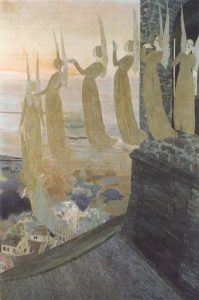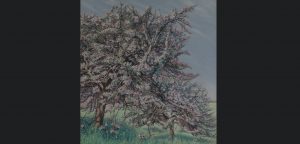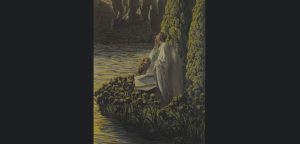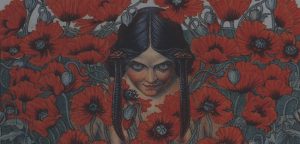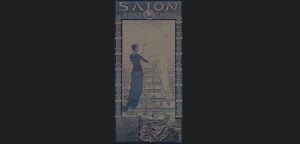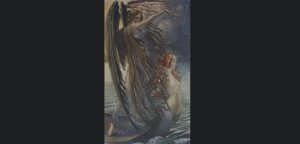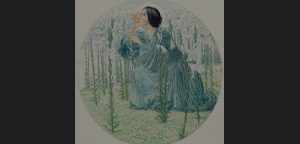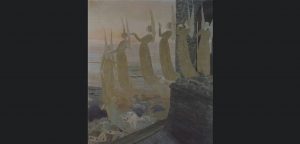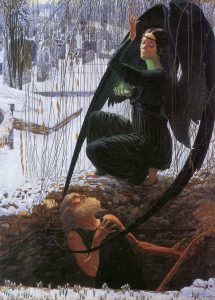He was born on the 21st of July in 1866 in Altona, Hamburg, Germany.
1866 - 1926
Carlos Schwabe
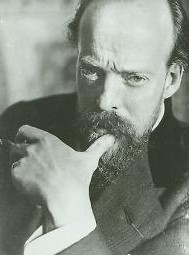
description
A Swiss and French artist of German origin, illustrator, symbolist graphic.
Carlos Schwabe is recognized by art historians as one of the main forerunners of Art Nouveau. He received high awards – a gold medal at the World Exhibition in Paris (1900), membership in the French Legion of Honor (1901). The artist was an illustrator of the lifetime magazines of E. Zola, C. Baudelaire, M. Maeterlink and A. Samain.
Key ideas:
– The main moods of the symbolist canvases of the earlier period of his work are despair and pessimism. Schwabe created paintings using various meaningful hints, giving the subjects mysterious and often mystical content. These features allow specialists to find a kind of “Gothic Symbolism” in his heritage. The main picture from a rather extensive catalog is “The Undertaker and the Angel of Death” (another name is “Death of the Grave-digger”). It is rightfully considered a masterpiece of art, and not only Symbolist. The artist uses a diagonal composition and expressive contrasting palette. At the same time, the apparent absence of the usual attributes – a hood, a black hoodie and a braid – will not deceive anyone. For example, the braid is very reminiscent of the wings in its outlines; in the hand of the Angel of Death, there is a literal unambiguous symbol – the soul of a gravedigger in the form of a greenish flame. So gracefully and picturesquely, in no other work, the angel was presented – it is difficult to tear off the eyes from the canvas.
– In works that are close in style to Art Nouveau, where the author uses rich ornaments, more often florals, the Virgin Mary, muses and angels become the heroes. Due to the expression of the depicted emotions, the canvas “Wave”, the most famous one created by Schwabe in the 21st century, stands alone. Working on the composition, Schwabe made many sketches, and they, making a very strong impression, are perceived as independent works (“Wave 1, 2”, etc.). The artist scrupulously searched for the position of the bodies, facial expressions for the sharp expression of tragedy, horror, grief on the faces of silently screaming women covered by a high wave. The painting is like a bright warning about the chaos that will come with the beginning of the First World War, like «The Scream» by Munch.
– Of the large number of illustrations to the works of literary contemporaries, the most famous was “Tosca and Ideal” (“Spleen et Idal”, 1900) for the compilation of Baudelaire. It began to appear as an independent work; in 1907, Schwabe made two of its variations – in watercolor and in oil painting technique. Drawings, like paintings, combine the features of Symbolism and decorativeness – therefore, the beginnings of Art Nouveau.
1866
1882 - 1884
1888 - 1890
1891
1892
1893 - 1899
1900 - 1907
1908
1920
1926
Рождение художника
He studied at the Geneva Industrial Art School
He studied at the Geneva Industrial Art School.
Received Swiss citizenship and moved to Paris
Received Swiss citizenship and moved to Paris.
Exhibited his works at the "Societe Nationale"
Exhibited his works at the “Societe Nationale”.
Created a poster for the first exposition of the Society "Rose and Cross"
Created a poster for the first exposition of the Society “Rose and Cross”; at the Autumn Salon, illustrated the novel “Dream” by E. Zola, M. Maeterlinck’s play “Pelleas and Melisande”.
Exhibited his works at the Munich Secession
Exhibited his works at the Munich Secession.
He was awarded the honorary title of the officer of the French Legion of Honor
Created illustrations for the compilation of poems by Charles Baudelaire “Flowers of Evil”; he was awarded a gold medal at the World Exhibition in Paris; was awarded the honorary title of the officer of the French Legion of Honor; his solo exhibitions were held in Belgium and Switzerland (Zurich).
Illustrated the book of A. Samain "In the garden of the Infanta", a collection of F. Lamennes "Words of a believer"
Illustrated the book of A. Samain “In the garden of the Infanta”, a collection of F. Lamennes “Words of a believer”.
The personal exhibition was held in Geneva.
A personal exhibition was held in Geneva.
The death of the artist
He died on the 22nd of January in 1926 in Avon, France.

